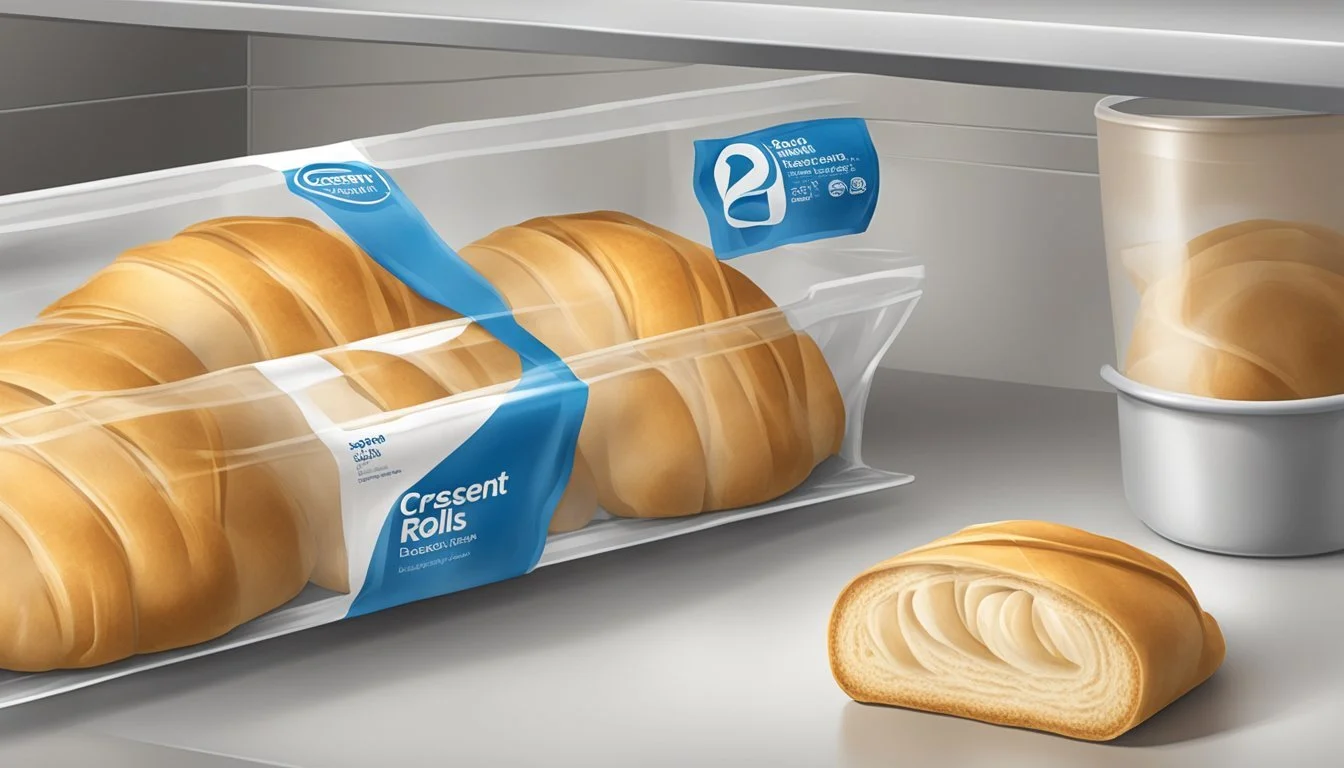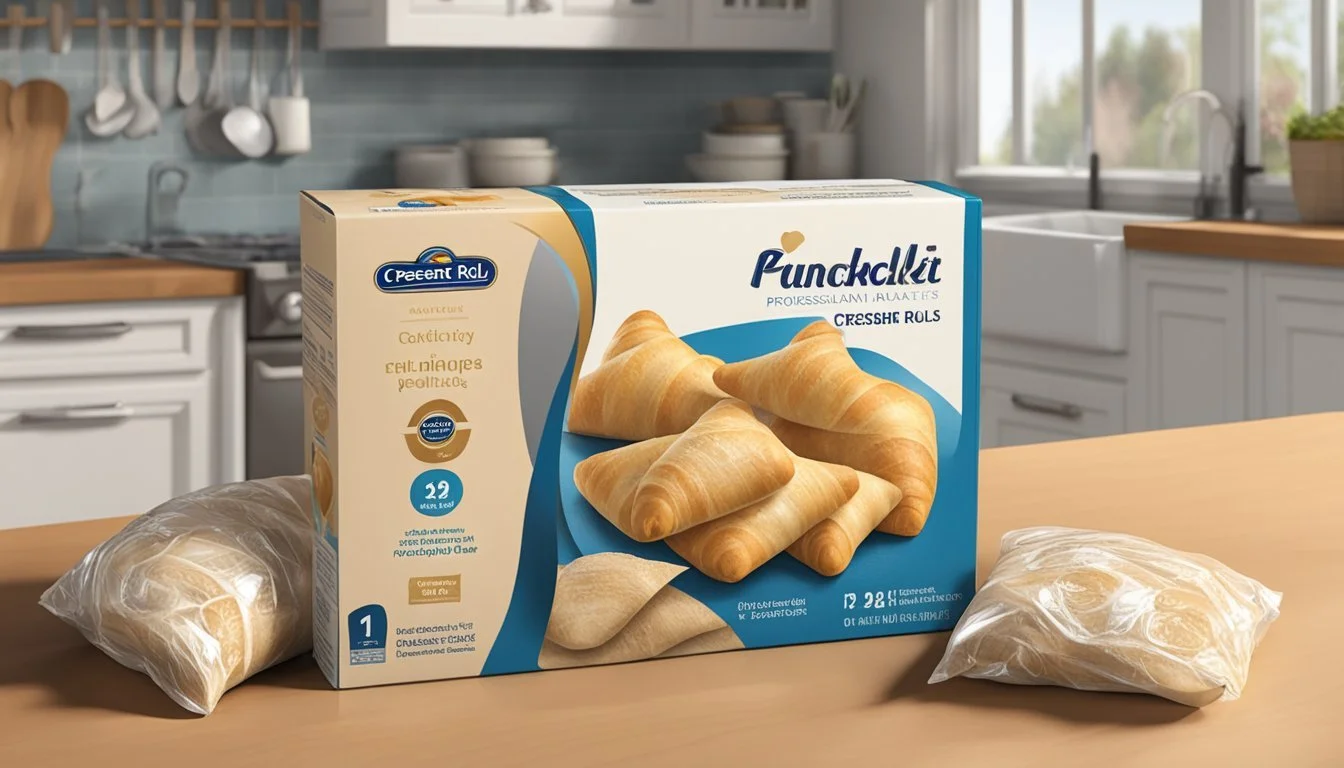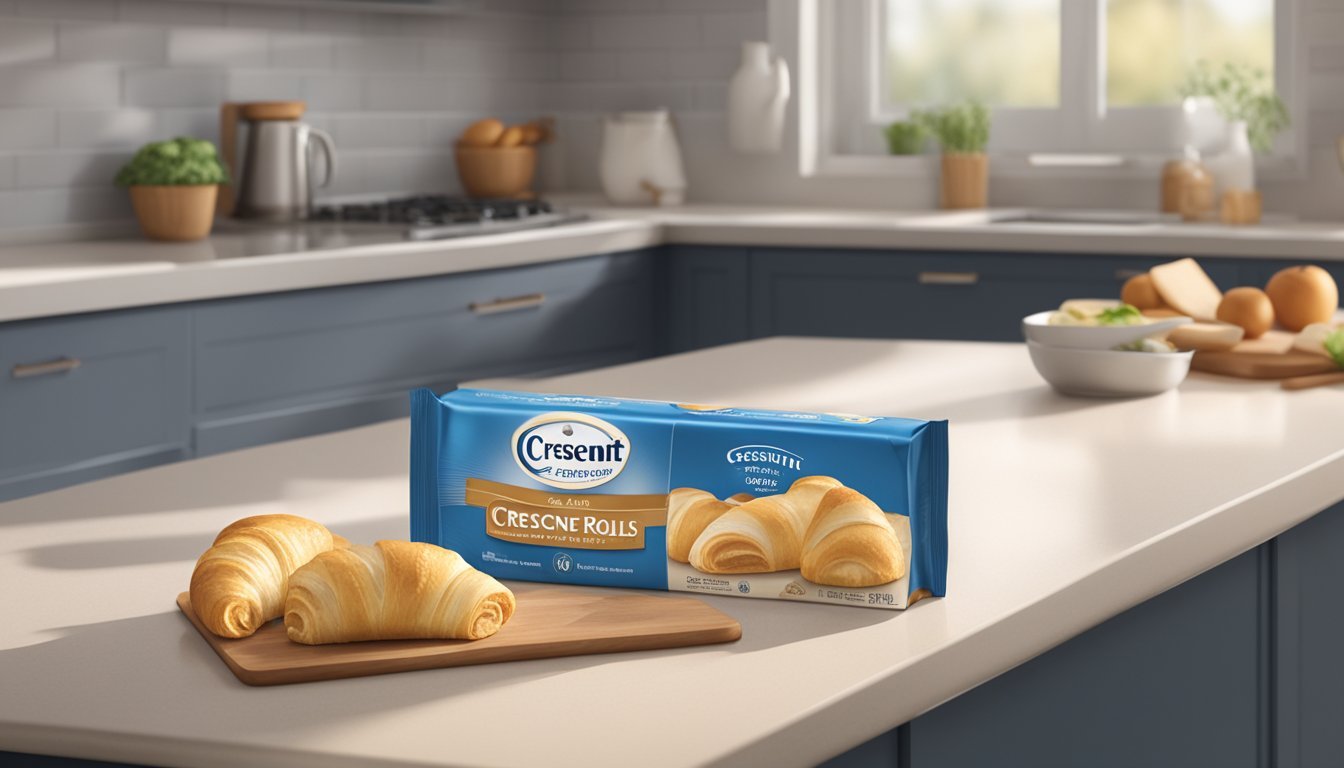Do Crescent Rolls Go Bad?
Shelf Life and Storage Tips
Crescent rolls are a beloved pastry that many enjoy for their light, flaky texture and delicious taste. Baking enthusiasts often keep these doughy delights on hand, but the question arises: do crescent rolls go bad? Yes, crescent rolls can go bad, and their freshness largely depends on how they are stored and the expiration date provided.
Commercially prepared crescent rolls come with a 'best by' date, which indicates the peak quality of the product. Consuming them past this date means they might lose some of their freshness and taste. Visible signs, such as mold, an off smell, or changes in texture, suggest that the rolls are no longer safe to eat.
Proper storage plays a crucial role in maintaining the quality of crescent rolls. Keeping them in cool, dry conditions and ensuring they are sealed in airtight packaging can help extend their shelf life. If you follow these storage tips, you can enjoy your crescent rolls at their best.
Understanding Crescent Rolls
Crescent rolls are a popular type of pastry known for their flaky texture and buttery taste. This section explores the core ingredients and various types of crescent rolls, as well as compares them to French croissant rolls.
Ingredients and Types
Crescent rolls typically consist of flour, yeast, sugar, salt, and fat sources like butter or vegetable shortening. These ingredients create a dough that is soft yet structured.
Different brands and recipes may include additives or preservatives to increase shelf life. Pillsbury Crescent Rolls, for example, are a well-known commercial variety that can be found in most supermarkets and will often contain artificial ingredients.
Homemade crescent rolls might also incorporate additional ingredients like eggs or milk to enhance flavor and texture. The balance of ingredients is critical to achieving the roll's quintessential flakiness.
There are sweet and savory variations, including fillings like chocolate, cheese, or ham.
Comparison to French Croissant Rolls
While they might look similar, crescent rolls and French croissant rolls differ in key ways. Crescent rolls typically use butter or vegetable shortening and employ a more straightforward rolling technique.
French croissant rolls, on the other hand, often use large amounts of butter and involve a labor-intensive folding process known as lamination, which creates multiple thin layers of dough and butter.
This difference in technique results in a croissant with a more intricate, airy texture and a richer flavor profile.
Commercial crescent rolls, like those from Pillsbury, are designed for convenience and ease of baking, whereas traditional French croissant rolls require time, skill, and patience to prepare correctly.
Both pastries offer distinct experiences and cater to different preferences in taste and preparation effort.
Shelf Life and Expiration
The shelf life of crescent rolls varies based on storage conditions, and the expiration date serves as a guideline for peak quality. Consumers should note several factors that can influence whether their crescent rolls are still safe to eat.
Determining the Expiration Date
Expiration dates on crescent roll packaging typically indicate the period during which the product maintains its expected quality. Unopened rolls often remain good for up to three weeks past the printed date if stored properly.
These dates help consumers gauge when the product might lose its texture or taste, though it may still be safe to eat for a short time beyond this period.
Key points:
Printed expiration date: Indicates peak quality.
Unopened rolls: Can last beyond the printed date if stored well.
Visible signs of spoilage: Mold or odd smell means they should be discarded.
Factors Influencing Shelf Life
Several factors affect the shelf life of crescent rolls. Proper storage in cool, dry conditions can significantly extend their usability. Exposure to heat, humidity, or improper sealing can accelerate spoilage.
Here are some significant factors:
Storage temperature: Keep rolls in cool places to maintain freshness.
Packaging: Airtight packaging helps prevent contamination.
Exposure to elements: Humidity and heat can shorten shelf life.
Important considerations:
Keep rolls in a cool, dry environment.
Use airtight containers or original packaging to ensure freshness.
Avoid exposure to high temperatures and humidity to extend shelf life.
Storage Guidelines
Proper storage is essential to maintain the quality and safety of crescent rolls. Depending on the storage method, the duration for which crescent rolls remain fresh may vary significantly.
Refrigerator Storage Best Practices
Crescent rolls should be stored in their original packaging or an airtight container in the refrigerator.
Once opened, sealing any unused rolls in plastic wrap or aluminum foil can prevent moisture loss and contamination.
Refrigerated crescent rolls should be consumed within 2 to 5 days to ensure they remain fresh. It is crucial to keep the storage temperature at or below 40°F to inhibit bacterial growth and maintain quality.
Freezer Storage Tips
Freezing crescent rolls can significantly extend their shelf life. When properly stored in a freezer, they can retain their quality for 2 to 3 months.
Wrap the rolls tightly in plastic wrap or aluminum foil and place them in a freezer-safe bag or container to prevent freezer burn. Clearly label with the date of freezing to track their storage duration.
Before consumption, allow the rolls to thaw in the refrigerator overnight for best results.
Pantry and Room Temperature Conditions
Crescent rolls should generally not be stored at room temperature for more than 2 hours.
In a cool, dry pantry with low humidity, unopened packages may last until their expiration date, but opened rolls are more susceptible to spoilage.
Storing at temperatures above 40°F can accelerate mold growth and spoilage, increasing the risk of foodborne illness. Always store crescent rolls in airtight containers to protect them from moisture and contaminants.
Identifying Spoilage
Recognizing spoilage in crescent rolls involves observing visual signs, texture, flavor, and odor. These indicators can help determine their edibility and prevent health risks.
Visual Signs
The appearance of crescent rolls is the first clue to identifying spoilage. One should look for changes in color such as unusual spots or discoloration. The growth of mold, which appears as blue, green, or white fuzzy spots, is a clear indicator that the rolls are not safe to consume.
If the rolls appear excessively dry or shrunken, this might also signal spoilage. Keeping an eye out for these visual cues can help avoid consuming expired products that could be harmful.
Changes in Texture and Flavor
Texture plays a crucial role in the spoilage detection of crescent rolls. Fresh rolls are typically soft and flaky. If they become bitter, excessively hard, or doughy, they might have gone bad.
Flavor changes are important too. Spoiled crescent rolls may taste sour, stale, or unusually bitter. These changes are often due to bacterial or mold growth, making the rolls unsafe.
Odor as an Indicator
A sour or off smell is one of the most reliable signs that crescent rolls are no longer fresh. Fresh rolls usually have a pleasant, yeasty aroma. When they spoil, they may emit a sour, musty, or moldy odor.
A musty or rotten odor is a strong indication of bacterial growth. Always trust your nose; if the rolls smell off, it's best to discard them to avoid potential health risks.
Safety and Consumption
To ensure safe consumption of crescent rolls, one must evaluate their suitability before eating and understand the health risks associated with spoiled rolls. Taking preventive measures can help avoid foodborne illnesses.
Evaluating Suitability for Consumption
Expired crescent rolls can sometimes be safe to eat depending on storage conditions and signs of spoilage. Check for changes in smell, texture, and appearance.
If the rolls smell off, have mold, or a sticky texture, discard them. Refrigeration can extend their life for 2 to 5 days after opening. If frozen, they may last 2 to 3 months past their "best by" date. Always store them in a cool, dry place with minimal air exposure to maintain quality.
Health Risks Associated with Spoiled Rolls
Consuming spoiled crescent rolls can lead to foodborne illnesses such as food poisoning. Harmful bacteria like Salmonella and E. coli can cause symptoms such as nausea, vomiting, diarrhea, and stomach cramps.
Severe cases may require hospitalization, especially in vulnerable populations like infants, elderly, or those with weakened immune systems. Allergic reactions may also occur if mold spores are present. Always check the expiration date and discard any suspect rolls to minimize health risks.
Preventing Foodborne Illness
Proper storage and handling of crescent rolls are crucial to prevent foodborne illnesses. Store unopened rolls in a cool, dry place. Once opened, refrigerate them and consume within a short period.
Freezing can help extend their shelf life for a few months. Clean hands and utensils before handling. Regularly check stored rolls for signs of spoilage, and keep them away from humidity and excessive air exposure. These practices help reduce the buildup of harmful bacteria and ensure the rolls remain safe to eat.
Maximizing Freshness and Quality
To keep crescent rolls at their best quality, proper wrapping and freezing methods are crucial. These techniques help maintain freshness, avoid freezer burn, and extend longevity.
Effective Wrapping Techniques
Wrapping crescent rolls carefully is essential for preserving their freshness and quality. Use airtight containers or sealed plastic bags to prevent exposure to air, which can lead to dehydration and spoilage.
For additional protection, wrap the rolls in plastic wrap or aluminum foil before placing them in the airtight container. This extra barrier can help in minimizing contact with air and moisture, maintaining the rolls' best condition.
Label the packages with expiration dates to track their storage duration. Keeping the storage environment cool and dry further aids in preserving freshness.
Optimal Freezing and Thawing Methods
Freezing crescent rolls correctly can significantly extend their longevity. Place the wrapped rolls in a single layer on a baking sheet and freeze until solid before transferring them to a freezer-safe bag or container. This prevents them from sticking together.
Store the frozen rolls in the coldest part of the freezer to avoid temperature fluctuations, which can cause freezer burn.
When thawing, move the rolls from the freezer to the refrigerator and let them thaw overnight. This slow thawing process helps maintain moisture and texture, ensuring the rolls stay as close to their original quality as possible.
Use the rolls within 2-3 months to enjoy the best taste and texture.
Utilization and Creativity
Crescent rolls are versatile and can transform various meals with their unique flavor and texture. Their buttery, flaky layers make them suitable for numerous creative culinary endeavors.
Culinary Uses Beyond Breakfast
Crescent rolls aren't just for breakfast. They make excellent accompaniments to lunch and dinner as well. For lunch, they can be filled with meats such as ham or turkey, paired with cheese, and baked to a golden brown finish.
Dinner options include using crescent rolls as a crust for savory pies or as a topping for casseroles. Additionally, they can be formed into rolls or twists to complement soups and stews, adding a warm, flaky touch.
Recipe Ideas and Inspirations
Creative recipes include pepperoni pizza crescent rolls, where the rolls are filled with pepperoni and cheese, then baked until golden brown. Another idea is to prepare sweet treats like crescent roll apple turnovers, which combine apples, cinnamon, and sugar wrapped in a buttery crust.
Crescent rolls can also be stuffed with cream cheese and fruit for a simple but delightful dessert. For those who love baked goods, folding the rolls with chocolate or nuts can also make for a delicious snack or after-dinner treat. The possibilities are numerous and delicious.
Recognizing Quality Products
Identifying high-quality crescent rolls involves understanding the impact of brand variations and the role of preservatives and additives in maintaining freshness and optimal taste.
Brand Variations
Crescent rolls from different brands, like Pillsbury, present varying levels of quality and shelf life. Pillsbury, a well-known brand, often employs higher quality ingredients and more sophisticated packaging techniques, ensuring a longer shelf life.
Homemade or lesser-known brands might lack these advancements, resulting in a shorter shelf life. Pillsbury crescent rolls, for example, can sometimes still be fresh even beyond their printed expiration date, provided they are stored correctly.
When evaluating different brands, it's essential to consider their reputation and reviews regarding freshness and taste.
Preservatives and Additives
Preservatives and additives play a crucial role in maintaining the quality of crescent rolls. Brands like Pillsbury use various preservatives that help keep the rolls fresh for a longer period. Common additives might include sodium benzoate and potassium sorbate, which inhibit mold growth.
It's important to be aware of these chemicals as they ensure that even when stored for extended periods, the crescent rolls retain their optimal taste and texture. However, consumers should also be mindful of potential allergic reactions to certain additives.
Understanding these factors helps in recognizing quality products and making informed choices. Adjusting expectations based on the presence of preservatives can lead to better satisfaction with the product’s taste and longevity.
Sensory Experience of Crescent Rolls
Crescent rolls are best enjoyed when their sensory characteristics are at their peak, including their appearance, aroma, texture, and flavor profile. Recognizing the ideal qualities in these areas can enhance your appreciation of this popular pastry.
Ideal Appearance and Aroma
Fresh crescent rolls should have a golden-brown exterior that is evenly colored, indicating proper baking. The surface should be slightly shiny due to the butter or egg wash applied before baking. This visual appeal is essential as it suggests a well-executed product.
The aroma of crescent rolls is inviting, with a notable buttery and slightly sweet scent. This is largely due to the butter used in the dough, which becomes more pronounced as it bakes. Any off smells, such as sourness or mold, indicate spoilage and should prompt caution.
Texture and Flavor Profile
The ideal texture of a crescent roll is light and flaky. The layers should separate easily, providing a delicate, melt-in-the-mouth experience. When torn apart, the interior should be soft but not doughy, with clear layers that are airy yet cohesive.
In terms of flavor, crescent rolls should have a rich, buttery taste complemented by a subtle sweetness. The pastry should not taste sour, bitter, or otherwise unpleasant. If the rolls taste off or exhibit an unusual texture, they may be past their prime and should be discarded for safety reasons.










